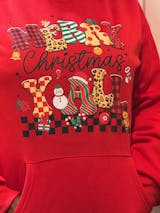Choosing the right fabric and understanding different apparel fits are essential for ensuring your DTF printed designs not only look amazing but also feel comfortable and last longer. Let’s explore common fabric types and fit terminology that you’ll encounter in custom apparel:
Cotton
Cotton is soft, breathable, and durable, making it a favorite choice for custom apparel. It absorbs moisture well, providing comfort and excellent print adhesion. Cotton garments deliver vibrant, long-lasting DTF prints, ideal for everyday wear.
Polyester
Polyester is a strong, lightweight synthetic fabric known for its resistance to wrinkles, shrinking, and fading. It's highly durable and offers excellent color vibrancy when printed. Polyester apparel is popular for sportswear, activewear, and performance clothing.
Cotton-Poly Blend
A cotton-poly blend combines the comfort of cotton with the durability and wrinkle-resistance of polyester. This blend delivers softness, easy care, and vibrant, long-lasting prints, making it ideal for casual clothing, uniforms, and promotional apparel.
Tri-blend Fabric
Tri-blend fabrics typically combine cotton, polyester, and rayon, creating an ultra-soft, lightweight, and comfortable garment. Known for their vintage, heathered look, tri-blends offer excellent drape, softness, and a unique style ideal for fashion-forward apparel.
Combed and Ringspun Cotton
Combed and ringspun cotton is premium-quality cotton processed to remove impurities and short fibers, resulting in a smoother, stronger, and softer fabric. This type of cotton offers superior print clarity, making it perfect for high-quality custom apparel.
Jersey Knit
Jersey knit is a stretchy, lightweight fabric characterized by a smooth face and slightly textured back. Commonly used in T-shirts and casual apparel, jersey knits offer comfort, softness, and excellent printability, ideal for vibrant, detailed designs.
Moisture-Wicking
Moisture-wicking fabrics draw sweat away from the skin, keeping the wearer dry and comfortable. Commonly used in athletic wear and activewear, moisture-wicking garments offer superior comfort, breathability, and excellent compatibility with durable DTF prints.
Performance Fabric
Performance fabrics include polyester or blended materials specifically engineered for active or athletic wear. These fabrics provide stretch, moisture control, breathability, and enhanced durability, ensuring comfortable wear and lasting print quality.
Pre-Shrunk
Pre-shrunk garments undergo special processing to minimize shrinking after washing. Choosing pre-shrunk apparel ensures consistent sizing, maintaining your custom DTF designs' appearance and fit even after repeated washing.
Standard Fit
Standard fit offers a classic, relaxed, comfortable silhouette suitable for most body types. This universally flattering fit makes it ideal for custom apparel, promotional clothing, or casual wear, ensuring broad appeal and comfort.
Slim Fit
Slim fit apparel features a closer-to-body cut, providing a tailored, modern appearance. Perfect for fashion-conscious or younger demographics, slim-fit garments offer stylish comfort while highlighting your vibrant printed designs.
Relaxed Fit
Relaxed fit clothing offers extra room, comfort, and ease of movement. It provides a casual, comfortable style ideal for everyday wear, leisure activities, or anyone who prefers loose-fitting garments without sacrificing style or print quality.
Athletic Fit
Athletic fit apparel is designed with slightly narrower shoulders and a tapered waist to flatter athletic or muscular builds. Ideal for sports or activewear, this fit emphasizes physique and comfort while showcasing your designs prominently.
Side-Seamed
Side-seamed garments feature seams running along both sides, enhancing fit, durability, and shape retention. These garments maintain consistent sizing, offer improved comfort, and deliver superior appearance and quality in printed apparel.
Crewneck
A crewneck is a classic, rounded neckline that sits comfortably at the base of the neck. Popular in T-shirts and sweatshirts, crewnecks provide a timeless, versatile style, perfect for displaying vibrant, eye-catching printed designs.
V-Neck
V-neck garments feature a neckline shaped like the letter "V," creating a flattering visual effect that elongates the neck and torso. They’re stylish and versatile, ideal for fashion-forward custom apparel that complements detailed, attractive prints.
Scoop Neckline
A scoop neckline is wide and rounded, offering a feminine, stylish, and relaxed look. It enhances comfort and style, perfect for casual wear, fashionable apparel, and showcasing creative, artistic DTF designs.
Henley Neckline
A Henley neckline features a partial button placket on a collarless shirt. Combining casual comfort with distinctive style, Henleys are popular for layering, casual fashion, or stylish custom apparel that benefits from unique, versatile design placement.




